2020 February
2018 December August June February
2017 December September June March
2016 November August June March
2015 December October July May February
2014 December October July April February
2013 December October August May February
2012 December September July April February
2011 December September July April February
from the February, 2014 issue of Kiai!
Pearls from Promotion Essays
By Color Belts Who Advanced in Rank on February 1, 2014
with photos taken during the oral portion of their test.
Advanced Brown Belt
 Arturo Jauregui
Arturo Jauregui
Most conflicts can be resolved without violence. Conflict usually arises from misunderstandings between individuals. I have been on both ends of mistakes in my sparring encounters at the dojo. … Each time a mistake caused by unnecessary physical force has occurred I have found a way to engage in dialog with my fellow karateka involved in the particular incident. Together we discuss the incident, acknowledge our mistake, and emphasize no harm was intended. It is the ensuing mutual respect between my counterpart and I that allows us to move forward without any reservations.
Brown Belts
The brown belt essay assignment included reading the autobiography of Gichin Funakoshi Sensei and finding its reflections in our Seido karate practice.
 Erin Epperson
Erin Epperson
While in some situations it may be necessary to physically fight, it is a core tenet of Thousand Waves’ approach to self-defense to use the least violent approach to conflict resolution possible. As we teach in our self-defense [Violence Prevention] classes, it is safest (and as karateka, more ethical) to use the Think, Yell, and Run fingers [of self-defense] first. … While Funakoshi Sensei and Kaicho use different language, I think their writings on concepts such as pride, respect, and courtesy express much of the same ideas about the responsibility that being a karateka confers on us to be as non-violent in our lives as possible. And that is something I’m happy to strive to be!
 Tabitha Balakumar
Tabitha Balakumar
In Karate-Do: My Way of Life, Funakoshi Sensei clearly states what karate is, and also what it is not. It is not a means for showing off, for going on the offensive, or for claiming superhuman feats. He says over and over that the real power of karate is in defense. In Karate-Do Kyohan, he says “The secret principle of martial arts is not vanquishing the attacker but resolving to avoid an encounter before its occurrence.” … The “Ethic of Least Harm” taught at Thousand Waves holds the same philosophy, as well as “Code of Ethics #5, Responsibility: ‘A karateka takes responsibility for his or her actions, and never raises a fist in anger.’ ”
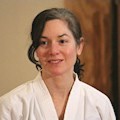 Debra Swan
Debra Swan
For Funakoshi, courtesy is a main tenet of karate-Do. He contends, “He who thinks about himself alone and is inconsiderate of others is not qualified to learn karate-do. Serious students of the art are always highly considerate of one another.” … Through love of family and friends, the true meaning of karate can be realized. Likewise, two of the fundamental principles of Seido are respect and love. We should treat others with courtesy and equanimity and from this respect grows love.
 Autumn Fox
Autumn Fox
Funakoshi clearly believed that karate is for everyone. … He strongly believed that karate was not about performing miraculous feats, but about achieving growth through focused training. And he believed that anyone could do this. His wife often trained with him, and he respected her mastery of the art. The idea that karate is for everyone was at the core of Kaicho’s philosophy in founding Seido, and is built into the way that Thousand Waves operates, from the ASK program [for children with disabilities] to the diverse range of people who train in karate.
Advanced Green Belts
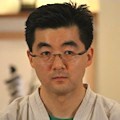 Kenji Muro
Kenji Muro
Along with the basic techniques and kata, kumite [sparring] represents the expression of our martial art. However, unlike the basic techniques and kata, whose technical nuances are described and demonstrated in precise manner, kumite shows us the application of karate, mimicking the unarmed citizen resistance/rebellion for which it was first intended. Its flowing nature and simultaneous defense/offense, along with the consideration of tactics and distancing, and combination of hand and leg techniques bewilder my more concrete-sequential approach to learning.
 Fay Cheng
Fay Cheng
Senpais that I have had the pleasure of learning from have taught me that it is okay to get hit. Everyone gets hit. You take the hit, let it go and keep going. Sparring is like a meditation on being in the present. You cannot hang on to that last hit because another one is coming; many more are coming. You need to learn from your last mistake and keep moving forward now. If you do not get hit, if you do not lose, you will not have the opportunity to improve.
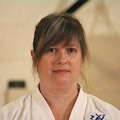 Ellen Gibbon
Ellen Gibbon
Proper ibuki breathing practiced regularly can help improve our posture and develop a strong core. It can help you generate power more efficiently and effectively. It can improve your lung health through expelling toxins caught in the lowest areas of your lungs. It can bring about the meditative calmness that accompanies focused, intentional breathing. It can help us all become more powerful karateka.
Green Belts
The green belt essay assignment also included reading the autobiography of Gichin Funakoshi Sensei. They were asked to write about the historical and philosophical meaning of changes he made to karate. One of these changes was to the name of karate itself, from karate-jutsu to karate-do.
 Sandy Markiewicz
Sandy Markiewicz
Karate means “empty hand” in Japanese. Jutsu is a Japanese term that refers to a physical ability. When combined, Karate-jutsu means “the techniques of the empty hand” meaning punching, kicking and foot work with no ethical, mental or philosophical aspirations. … Do on the other hand means “way” and implies a system of study that includes knowledge, tradition, philosophy and ethics. Do indicates that karate is not just a method of punching and kicking, but a way of living and thinking. Thus, Karate-do means “The WAY of the Empty Hand” and is a complete system of traditional study with physical, mental, philosophical and ethical development involved.
 John Cusick
John Cusick
In The 20 Precepts of Karate-do, Funakoshi Sensei makes clear that martial practice is a way of life, not a fighting system. Precept number one states that Karate begins with Rei, or respect. I have seen this precept demonstrated daily at Thousand Waves. Examples include bowing in, taking time to acknowledge our teachers and training partners, and listening to feedback without interruption. This and all the precepts have applications to life beyond the dojo.
Advanced Yellow Belts
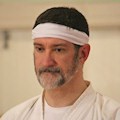 Christopher Lamitie
Christopher Lamitie
I think of meditation as training for the mind. In karate we train our bodies, but the mind too, needs training. A significant concept in Seido Juku is relaxation then swift, decisive action. Much like moving in sanchin dachi, we relax through the movement, then we set and are strong and immovable. Meditation accomplishes this for the mind – to be in a relaxed state, yet ready for action.
 Marlana May Carlson
Marlana May Carlson
On Wednesday evenings, as much as possible, I very much enjoy meditation class, where we practice zazen, or sitting meditation. I often struggle with self-motivation to meditate at home, so I find it very helpful and encouraging to practice in a group. I also appreciate the energy of others in the circle and it re-emphasizes my feelings of being a part of something greater in the universe. When I participate in zazen, I feel my energy bubbling up, so it reminds me that it’s there, and I get to learn how to harness it in beneficial ways.
Yellow Belts
 Cynthia Dieden
Cynthia Dieden
The realization that after the blue belt test, we do not stop practicing Taikyoku one and two was significant. Each kata remains a work in progress. It has been tempting to think that I “know” a kata because I have gone through it many times. … I am reminded how misguided this is every time I train in a multibelt class and do Taikyoku one with people who learned it years and years before.
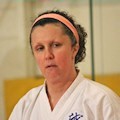 Rosalia Scholle
Rosalia Scholle
I love that I get to practice my Taikyoku kata over and over again. It allows me to take the wider view, and not have to focus on the directionality as much as making my stances better. … I learned to face a challenge that I never thought I could do: Taikyoku 1 with my eyes closed. Because I feel so safe in our dojo, I was able to keep my eyes closed. I was scared and a little bit dizzy! I am challenging myself in ways that help me outside of my karate practice.
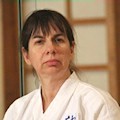 Mariana Von Wald
Mariana Von Wald
Since I have begun my training in Seido Karate, my understanding of self-defense has definitely changed. …I thought you had to be an expert fighter to defend yourself. Now I see thankfully that anyone can defend themselves. That the whole point of self-defense training is to get away in one piece. Get off the line in the most efficient way, and target only the most vulnerable spots if you can. Also, to use your voice as a weapon and RUN!
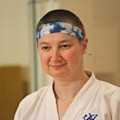 Paula Clayton
Paula Clayton
Who knew bouncing around back and forth and throwing punches at nothing could take so much effort? Anyone who has done something like sparring, I guess. What a surprise. As I attend more pre-sparring classes I expect my aerobic fitness will improve, I will start to be able to think while moving (Strategy – page 97 in the study guide), gain greater skill and appreciation of the technical elements, and continue my journey of connecting myself to the world around me.
